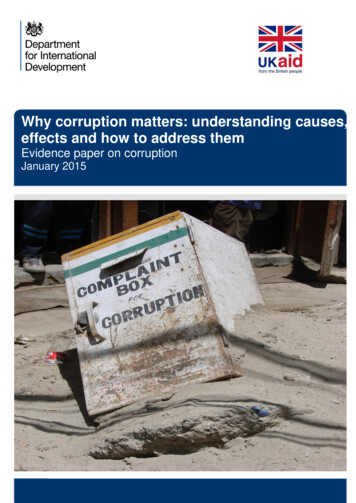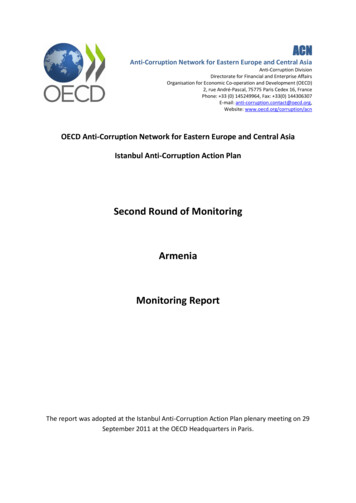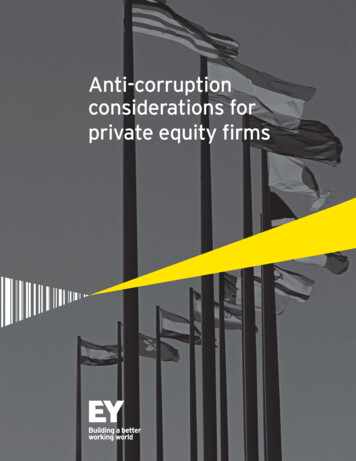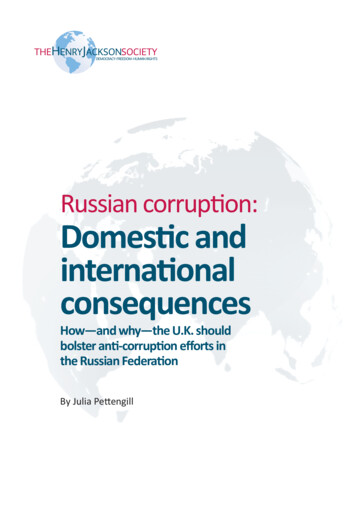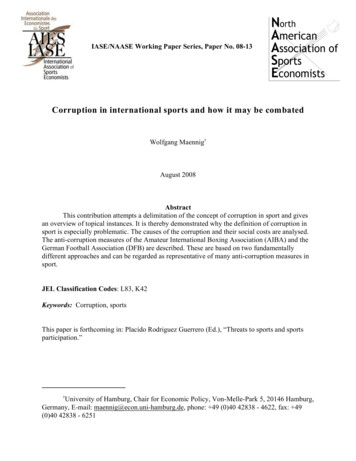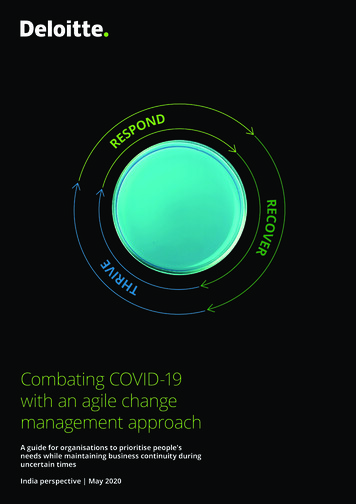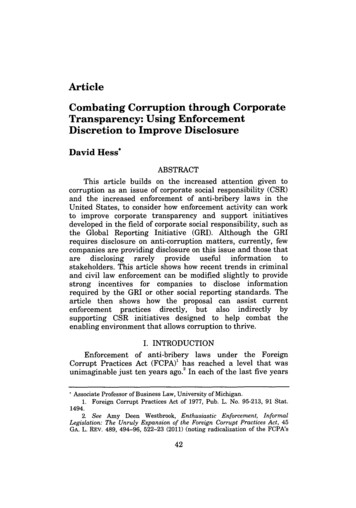
Transcription
ArticleCombating Corruption through CorporateTransparency: Using EnforcementDiscretion to Improve DisclosureDavid Hess*ABSTRACTThis article builds on the increased attention given tocorruption as an issue of corporate social responsibility (CSR)and the increased enforcement of anti-bribery laws in theUnited States, to consider how enforcement activity can workto improve corporate transparency and support initiativesdeveloped in the field of corporate social responsibility, such asthe Global Reporting Initiative (GRI). Although the GRIrequires disclosure on anti-corruption matters, currently, fewcompanies are providing disclosure on this issue and those thatare disclosing rarely provide useful information tostakeholders. This article shows how recent trends in criminaland civil law enforcement can be modified slightly to providestrong incentives for companies to disclose informationrequired by the GRI or other social reporting standards. Thearticle then shows how the proposal can assist currentenforcement practices directly, but also indirectly bysupporting CSR initiatives designed to help combat theenabling environment that allows corruption to thrive.I. INTRODUCTIONEnforcement of anti-bribery laws under the ForeignCorrupt Practices Act (FCPA)' has reached a level that wasunimaginable just ten years ago.2 In each of the last five yearsAssociate Professor of Business Law, University of Michigan.1. Foreign Corrupt Practices Act of 1977, Pub. L. No. 95-213, 91 Stat.1494.2. See Amy Deen Westbrook, Enthusiastic Enforcement, InformalLegislation: The Unruly Expansion of the Foreign Corrupt Practices Act, 45GA. L. REV. 489, 494-96, 522-23 (2011) (noting radicalization of the FCPA's42
2012]COMBATING CORRUPTION43the Department of Justice (DOJ) has set a record for thenumber of enforcement actions, with the number ofenforcement actions in 2010 almost double that of the previousyear. In the words of the Assistant Attorney General for theCriminal Division, "FCPA enforcement is stronger than it'sever been - and getting stronger." This level of enforcementactivity has made the risk of FCPA violations a top issue partments are unsure how to respond because there is asignificant level of uncertainty about what actually constitutesa violation of the FCPA.6 This makes it difficult for compliancedepartments to provide necessary guidance or to implementeffective internal controls, especially when faced with thedemands of business managers who believe their competitorsare not playing by the rules.'The DOJ encourages corporations to work through thesechallenges themselves and to self-regulate by improving theircompliance programs. The DOJ does this by granting leniencyenforcement and tremendous increase in enforcement activity as compared tothe 1980s and 1990s); Lauren Giudice, Regulating Corruption: AnalyzingUncertainty in Current Foreign Corrupt Practices Act Enforcement, 91 B.U.L.REV. 347, 348 (2011) (noting that between 2006 and 2009 "the DOJ hasbrought about sixty FCPA cases, which is more than the total number of casesbrought in the thirty-two years between the Act's inception in 1977 and2005."); Mike Koehler, The Foreign CorruptPracticesAct in the Ultimate Yearof Its Decade of Resurgence, 43 IND. L. REV. 389, 389 (2010) (stating that"during the past decade, enforcement agencies resurrected the FCPA fromnear legal extinction.").3. F. Joseph Warin et al., 2010 Year-End FCPA Update, INSIGHTS: THECORP. & SEC. L. ADVISOR, Jan. 2011, at 26, 26. In short, the Department ofJustice (DOJ) is responsible for criminal enforcement of the FCPA and theSecurities Exchange Commission (SEC) is responsible for civil enforcement.Koehler, supra note 2, at 395-396.4. Lanny A. Breuer, Assistant Attorney Gen., Dep't. of Justice, Addressat the 24th National Conference on the Foreign Corrupt Practices Act 6.html).5. See Jaclyn Jaeger, Bribery Act Setting a New Standard forCompliance, COMPLIANCE WK., Jan. 2011, at 1, 1; Melissa Klein Aguilar,FCPA Compliance: Latest, Best Practicesfor Boards, COMPLLANCE WK., Sept.2010, at 53, 53.6. See generally James R. Doty, Toward a Reg. FCPA: A Modest Proposalfor Change in Administering the Foreign Corrupt PracticesAct, 62 BuS. LAW.1233 (2007) (describing Doty's criticisms of FCPA enforcement).7. See generally CONTROL RISKS GROUP LTD. & SIMMONS & SIMMONS,INTERNATIONAL BUSINESS ATTITUDES TO CORRUPTION-SURVEY 2006 5(2006) (providing data on managers' beliefs that competitors are payingbribes); ERNST & YOUNG, CORRUPTION OR COMPLIANCE - WEIGHING THECOSTS: THE 10TH GLOBAL FRAUD SURVEY 6 (2008) (providing data onmanagers who believe corruption is getting worse).
44MINNESOTA JOURNAL OF INTL LAW[Vol. 21:1to corporations that have implemented effective FCPAcompliance programs, even when their employees are caughtpaying a bribe.8 There are complaints, however, that thegovernment is not providing sufficient guidance setting outwhat efforts are necessary to earn this protection.! Thegovernment, in turn, is wary of giving this advice for fear thatit will allow corporations to create the appearance of selfregulation through compliance programs which are easilyevaded by employees or exist only on paper.10 This articleconsiders how the DOJ can work toward solving these problemsby using and enhancing existing transparency initiatives in thefight against corruption.There is a strong need for the production anddissemination of new types of information related to thechallenges of combating corruption. The government needsinformation about the value of corporate efforts made towardscompliance in order to implement a more effective "credit forcompliance" program." Corporations need information that willallow them to adopt the anti-bribery best practices of otherplayers, and information to assure them that their competitorsare abiding by their commitments to combat corruption.Increasingly, other stakeholders, such as non-governmentalorganizations (NGOs) and social investors, are also seekinginformation on corporate anti-bribery efforts so that they canserve as surrogate regulators, pressuring corporations to liveup to their anti-bribery commitments, as well as assisting themin those efforts.12 In each of these ways, the development anduse of new information can help to combat the environmentsthat allow corruption to thrive.8. David Hess & Cristie L. Ford, Corporate Corruption and ReformUndertakings:A New Approach to an Old Problem, 41 CORNELL INTL. L.J.307, 329 (2008).9. See Ronald E. Berenbeim & Jeffery Kaplan, Ethics and ComplianceEnforcement Decisions - the Information Gap, in EXECUTIVE ACTION SERIES,at 1, 2 (The Conference Board, Ser. No. 310, 2009).10. William S. Laufer, CorporateLiability, Risk Shifting, and the Paradoxof Compliance, 52 VAND. L. REV. 1343, 1407-1408 (1999). See Kimberly D.Krawiec, Cosmetic Compliance and the Failure of Negotiated Governance, 81WASH. U. L. Q. 487, 491-92 (2003).11. See generally Cristie L. Ford, Toward a New Model for Securities LawEnforcement, 57 ADMIN. L. REV. 757, 788-92 (2005) (discussing how thegovernment would have to go through an enormous amount of informationfrom a corporation to determine which compliance programs are effective andwhich ones are not).12. See infra Part IV.C.1-C.2.13. See infra Part IV.C.1-C.2.
2012]1COMBATING CORRUPTION45A key first step in taking advantage of these opportunitiesis conceptualizing anti-corruption as an issue of corporatesocial responsibility (CSR), and not simply as an issue of legalcompliance. Just a decade ago, the topic of anti-corruption wasexcluded from many major CSR initiatives,14 but in the last fewyears it has become a central topic. 5 Viewing anti-corruption asan issue of CSR does not mean that combating corruption is apurely elective activity, akin to corporate philanthropy; itmeans that anti-corruption efforts involve acting consistentwith ethical values 6 and it means taking actions thatsimultaneously create economic value for the corporation andsocial value for society."14. Despite corruption's link to human rights violations, see INT'LCOUNCIL ON HUMAN RIGHTS & TRANSPARENCY INT'L, CORRUPTION ANDHUMAN RIGHTS: MAING THE CONNECTION 5-7 (2009), and other social andeconomic ills, see generally Elizabeth Spahn, Nobody Gets Hurt?, 41 GEO. J.INT'L L. 861 (2010) (explaining the ramifications of bribery on internationaleconomic and societal interplay), it was a forgotten component of CSR untilrecently. For example, two of most well-known and influential CSR initiativesdid not initially include the topic of corruption, but only added that elementlater. First, the most well-known set of standards on sustainability reporting,published by the Global Reporting Initiative, did not include disclosurerequirements on corruption in their first edition. David Hess & Thomas W.Dunfee, Taking Responsibility for Bribery: The Multinational Corporation'sRole in Combating Corruption, in BUSINESS AND HUMAN RIGHTS: DILEMMASAND SOLUTIONS 260, 269 (Rory Sullivan ed., 2003). Secondly, the originalversion of the United Nations Global Compact only had nine principles none ofwhich included corruption. It was only later that the 10th principle on fightingcorruption was added. Peter Eigen, Removing a Roadblock to Development:Transparency International Mobilizes Coalitions Against Corruption,INNOVATIONS, Spring 2008, at 19, 29. The explanation for these omissions isunclear, perhaps because CSR is often viewed as a corporation voluntarilygoing beyond compliance with the law, while a corporation fighting corruptionand bribery is viewed as mere compliance with the law. In addition, corruptionis often viewed as something that is forced on corporations by governmentofficials (the demand side of corruption), as opposed to something thatcorporations inflict on others (e.g., human rights violations or pollution of theenvironment).15. The issue of corruption is now included in leading standards oncorporate social responsibility, such as the United Nations (UN) GlobalCompact. U.N. Global Compact, The Ten Principles: Transparency and . See Alexander Dahlsrud, How Corporate Social Responsibility isDefined: An Analysis of 37 Definitions, CORP. SOC. RESP. & ENVTL. MGMT.,Nov. 2006, at 1, 8 (2006) (quoting the organization Business for SocialResponsibility) ("Corporate social responsibility is achieving commercialsuccess in ways that honour ethical values and respect people, communitiesand the natural environment.").17. Michael E. Porter & Mark R. Kramer, CreatingShared Value: How toReinvent Capitalism-andUnleash a Wave of Innovation and Growth, HARV.
46MINNESOTA JOURNAL OF INTL LAW[Vol. 21:1As in other areas of CSR, government intervention maydirectly mandate certain behavior, but it may also use thethreat of such mandates to cast a shadow over private actors,encouraging corporations to improve their behavior to avoidregulatory action." Governments have many ways of creatingan "enabling environment" for CSR," such as by endorsing,facilitating, or partnering with private and civil sectorentities."0 This article adds to the repertoire of governmentintervention by exploring how the typically more adversarialapproach of civil and criminal law enforcement can be used toencourage the disclosure of information, which in turn can beutilized by investors, NGOs, similar corporations and otherstakeholders to further the ultimate purposes of the antibribery laws.Part II of this article explains the difficulties of combatingcorruption. Part III discusses global initiatives to encouragecorporations to provide disclosure on corruption issues, and itevaluates the effectiveness of these practices. Finally, Part IVexplains how the DOJ's FCPA enforcement practices can beused to encourage this practice of disclosure and why doing soshould be expected to produce significant benefits.Bus.REV., Jan.-Feb. 2011, at 62, 66 ("Shared value creation focuses onidentifying and expanding the connections between societal and economicprogress."). See generally Michael E. Porter & Mark R. Kramer, Strategy &Society: The Link Between Competitive Advantage and Corporate SocialResponsibility, HARV. BUS. REV., Dec. 2006, at 78, 83-84 (discussing theconcept of "shared value").18. Aneel Karnani, "Doing Well by Doing Good": The Grand Illusion, CAL.MGMT. REV., Winter 2011, at 69, 83 ("It is primarily the role of thegovernment to force companies to change behavior to be congruent with thepublic interest."). See generally Thomas P. Lyon, 'Green' Firms Bearing Gifts,REGULATION, Fall 2003, at 36, 37-38 (describing how corporations use selfregulation, or at least the appearance of self-regulation, to avoid stricterregulation).19. TOM Fox ET AL., THE WORLD BANK, PUBLIC SECTOR ROLES INSTRENGTHENING CORPORATE SOCIAL RESPONSIBILITY: A BASELINE STUDY iii(2009).20. Id. at iv; see also U.S. GOV'T ACCOUNTABILITY OFFICE, GAO LEMENTU.S.BUSINESS'S GLOBAL CORPORATE SOCIAL RESPONSIBILITY EFFORTS 16-18(2005); Reinhard Steurer, The Role of Governments in Corporate SocialResponsibility:CharacterisingPublic Policies on CSR in Europe, 43 POL'Y SCl.49, 57 (2010).
2012]COMBATING CORRUPTION47II. THE PROBLEM OF CORRUPTIONA. CORRUPTION CONTINUESPreventing the use of bribes in domestic and internationalbusiness is one of the most challenging problems facingregulators.2 ' Although corporations may complain about theenforcement of the FCPA,22 they have many reasons to prefer acorruption-free environment. Corporations attempting tooperate in corrupt environments face unpredictable and highlyfrustrating difficulties that create numerous direct and indirectcosts. 23 Despite the long-term benefits to a corporation ofoperating in a corruption-free business environment, shortterm pressures frequently cause corporations to take actionsthat perpetuate the corrupt environment.24 The result is whatProfessor Nichols describes as an assurance problem. 2' Hestates:21. The challenge is seen as a paradox in that "corruption is universallydisapproved yet universally prevalent." David Hess & Thomas W. Dunfee,Fighting Corruption:A Principled Approach; The C' Principles (CombatingCorruption), 33 CORNELL INT'L L.J. 593, 595 (2000). This paradox seeminglycreates a never-ending cycle of corrupt business practices, as Gerald Caidenexplains, "Attempts to combat corruption on the metaphysical level seemsdoomed to failure since human nature is inherently flawed. In spite of anyprogress that is secured, corruption spawns like a plague unless vigilantlysuppressed. Even then, corruption can never be fully eradicated and foreverlurks in the background, ready to undermine whatever development has beenrealized, threatening to destroy civilization itself." Gerald E. Caiden, ACautionary Tale: Ten Major Flaws in Combating Corruption, 10 SW. J. L. &TRADE AM. 269, 271 (2004).22. See Mike Koehler, The Facade of FCPA Enforcement, 41 GEO. J. INT'LL. 907 (2010), for a thorough review of the criticisms. Violations of the FCPAcan also be costly for corporations. In addition to multimillion dollar penalties,corporations can face reputational damage for violations of the FCPA that maybe even more significant. PRICEWATERHOUSECOOPERS, CONFRONTINGCORRUPTION: THE BUSINESS CASE FOR AN EFFECTIVE ANTI-CORRUPTIONPROGRAMME 5 (2008).23. The direct costs include not only the cost of the bribe, but also suchcosts as bureaucratic delay, attempting to avoid situations where bribes arelikely to be demanded, and others. Jonathon P. Doh et al., Coping WithCorruptionin Foreign Markets, ACAD. MGMT. EXECUTIVE, Aug. 2003, at 114,115-17. Indirect costs for corporations include having to operate in a countrywith distorted public expenditures, a weak infrastructure, and other socioeconomic problems. Id. at 118. The magnitude of these costs on corporationsdepends on the pervasiveness of corruption and the arbitrariness of it, forexample not knowing if payment of a bribe has solved a problem or createdadditional new problems. Id. at 118-19.24. See Philip M. Nichols, Corruptionas an Assurance Problem, 19 AM. U.INT'L L. REV. 1307, 1326-28 (2004).25. Philip M. Nichols, Multiple Communities and Controlling Corruption,88 J. BUS. ETHICS 805, 805 (2009).
48MINNESOTA JOURNAL OFINTL LAW[Vol. 21:1[An assurance problem exists when actors are best off if theycooperate with one another, but in the event of cheating by anotheractor are better off if they themselves also cheat than they would be ifthey continued to comply with the rules. As the actors cannot monitorone another, they face uncertainty as to which course of action willyield the best result.2 6In the absence of assurance that others will not resort tocorruption, corporations "must choose between cooperating inhopes of accruing the greatest benefit or defecting as adefensive measure."27This assurance problem is demonstrated by the facts of arecent criminal FCPA case. When faced with a request from agovernment official for an illegal payment to win a contract, amanager at Baker Hughes, Inc. told one of the company's vicepresidents that "We are in the driving seat but if one [ofJ ourcompetitors comes in with a pot of gold, it is not going to be ourcontract."28 Competitive pressure,,combined with the perceptionof others' willingness to pay bribes, provided a strong incentivefor the managers to give in.29 A manager at Baker Hughesstated that the bribe request was "distasteful," but in the endthe company made the requested payment."Ordinarily, the primary solution for assurance problems isthe imposition of sanctions against defectors." Thus, one wouldexpect increased enforcement of the FCPA should help detercorrupt payments. But there is reason to be skeptical thatincreased enforcement will significantly reduce corruption anytime soon. The general consensus of business managers is thatcorrupt payments will continue to be a common activity.A 2010 Transparency International survey, with over26. Id.27. Nichols, supra note 24, at 1310.28. Deferred Prosecution Agreement, Attachment A at 4, 7-8, UnitedStates v. Baker Hughes Inc., No. 4:07-cr-00130-1 (S.D. Tex. 2007) available akerhughes.pdf; Compl. at 910, SEC v. Baker Hughes Inc., No. 07-cv-1408 (S.D. Tex. 2007) available mp20094.pdf.29. See Deferred Prosecution Agreement, Attachment A at 4, 7-8 UnitedStates v. Baker Hughes Inc., No. 4:07-cr-00130-1 (S.D. Tex. 2007) garrett/bakerhughes.pdf (the companychose to make the payment after an employee expressed concern that thecontract might be lost without it).30. Compl. at 9-10, SEC v. Baker Hughes Inc., No. 07-cv-1408 (S.D. complaints/2007/comp20094.pdf.31. Nichols, supra note 24, at 1310 (but this response is not alwayseffective in industries where corruption is prevalent).
2012]COMBATING CORRUPTION4990,000 respondents in eighty-six countries,3 2 found that amajority of people believed that corruption had increased overthe previous three years. Among respondents from theEuropean Union and North America, over two-thirds ofrespondents believed there had been an increase. In a studyfocused more specifically on business, Ernst and Young foundthat, although 23% of managers throughout the world thoughtregulatory enforcement had been "significantly stronger" overthe last five years, over one-third also thought that the problemof corruption was getting worse.35 Another recent survey foundthat 28% of U.S. managers thought corruption would increasein the next five years, 54% thought it would stay the same, andonly 12% thought there would be a decrease." The recentfinancial crisis also does not help matters. Pressures to protectthe company and for managers to protect personal bonuses,may lead employees to believe that corrupt payments arenecessary in the current environment.Furthermore, the current environment in many countriesis getting worse. In Pakistan, the results of a national surveysuggest that corruption increased 400% from 2006 to 2009.3832.TRANSPARENCY INT'L, GLOBAL CORRUPTION BAROMETER 2 cy-research/surveys-indices/geb/2010/results.33. Id. at 5.34. Id.35. ERNST & YOUNG, CORRUPTION OR COMPLIANCE - WEIGHING ance-weighing the-costs.pdf (survey of managers about their impressions ofcorruption levels). The survey data was based on telephone interviews with1,186 managers in large corporations from 33 different countries. Id. at 22.The interviews were conducted between November 2007 and February 2008.Id.36. CONTROL RISKS GROUP, supra note 7, at 21 (chart of respondents'expectations of whether corruptions would increase, stay the same, ordecrease, delineated by country). The remaining six percent indicated thatthey "did not know." Id. Similar results were obtained from managers in othercountries. Id.37. See generally ERNST & YOUNG, EUROPEAN FRAUD SURVEY 2009 ations/items/fraudeu 2009/200904 EYEuropeanFraudSurvey.pdf (showing that the more difficult the economic environmentbecomes, the more likely it is that individuals will commit fraud and cave tobribery demands). See also RONALD E. BERENBEIM, CONFERENCE BOARDRESEARCH REPORT: RESISTING CORRUPTION 9 (2006) (noting that manymanagers believe that the FCPA does not deter bribery because of the strongbelief that bribery is something that has to be done in some countries tosucceed).38. Press Release, Transparency International Pakistan, Corruption in
50MINNESOTA JOURNAL OF INT'L LAW[Vol. 21:1Similarly, a 2006 survey of executives by Control Risks Groupfound that 23% of U.S. managers believed that their companyhad lost business in the last year due to a competitor paying abribe, and 44% believed that this had occurred in the last fiveyears.39 This was an increase from 2002, when the survey foundthat 18% believed they had lost business due to bribes in thelast year and 32% believed that this had occurred in the lastfive years.40 Ernst and Young obtained similar results in a 2008survey, in which 24% of respondents indicated that they had41experienced an incident of bribery within the last two years.To reduce the supply of bribes, corporations must act to fillthe gaps left by legal enforcement. Corporations can do this bymaking a commitment to anti-corruption, demonstrating thatcommitment to competitors and to other stakeholders, and byallowing that commitment to be monitored. By encouragingappropriate transparency, government enforcement action canplay an indirect but valuable role in increasing corporateadoption of these practices. The exact nature of the requiredtransparency and its benefits are described below, 42 but first itis important to discuss the anti-corruption commitment that isneeded from corporations.B. COMPLIANCE CHALLENGESTo prevent the payment of bribes, corporations must adopteffective ethics and compliance programs.43 These programsrequire corporations to conduct risk assessments to determinewhen potential bribe payments are most likely; to implementinternal controls, with a special focus on the identified highrisk areas; to provide employees with training on ethics, anticorruption laws, and the company's code of conauct; toimplement a system for employees to report any suspectedLast Three Years has Increased 400% (June 17, 2009), available ish).pdf. These numbers come from anational survey conducted by the Pakistan chapter of TransparencyInternational. The press release concludes by stating "The NCP survey 2009results confirms that Pakistan has Laws, but not the Rule of Law." Id.39. CONTROL RIsKS GROUP, supra note 7, at 5.40. Id.41. ERNST & YOUNG, supra note 35, at 5. In addition, 18% of respondentsstated that their company had lost business in the last two years to acompetitor that paid a bribe. Id.42. See infra Part III.B and Part IV.C.43. See Mike Koehler, The Unique FCPA Compliance Challengesof DoingBusiness in China, 25 WIs. INT'L L.J. 397, 430 (2007).
2012]COMBATING CORRUPTION51violations; and to establish punishments for rule violators. Inthe United States, the government provides strong incentivesfor corporations to adopt such programs by using the quality ofa corporation's compliance program in determining whether ornot to prosecute the corporation for FCPA violations. Thequality of the compliance program also plays a role indetermining the severity of a corporation's sentence if it isconvicted of violating the FCPA.4 6Despite the strong incentives provided by theseenforcement activities, many corporations still have notimplemented a program that appropriately identifies andguards against risks of corruption. One survey found that"[olnly 25% percent of respondents say their company performsproactive risk assessments or monitoring" on corruptpayments.4 8 Additionally, only "40% of respondents believetheir controls are effective at identifying high-risk businesspartners or suspicious disbursements."4 9 Smaller corporationswere even less confident in the implementation of theircompliance programs.o In the summer of 2008, which beganthe DOJ's increased focus on FCPA enforcement, a similarsurvey found that although a majority of respondents had antibribery policies and training programs in place, less than halfhad developed protocols for conducting risk assessments orcontinuous monitoring of compliance.5 ' The anti-bribery policies44. For an overview of FCPA compliance programs, see generally MARTINT. BIEGELMAN & DANIEL R. BIEGELMAN, FOREIGN CORRUPT PRACTICES ACT:COMPLIANCE GUIDEBOOK 215-17 (2010) (list of factors).45. Robert W. Tarun & Peter P. Tomczak, A Proposalfor a United StatesDepartment of Justice Foreign Corrupt PracticesAct Leniency Policy, 47 AM.CRIM. L. REV. 153, 166-170 (2010) (describing federal agents' considerations indeciding whether or not to prosecute).46. Id. at 162-63.47. See PRICEWATERHOUSECOOPERS, supra note 22, at 13. Somecommentators argue that even for companies that attempt to implement acomprehensive FCPA compliance program, there will be significant challengesin designing many aspects of the program because of the government's unclearand changing enforcement practices. Westbrook, supra note 2, at 498-99. Forexample, Westbrook states: "Given the present state of confusion about whatthe law actually requires, it is unclear how to design an efficient and effectivecompliance program. As a result, FCPA compliance programs are likely to beoverly expensive, and probably insufficiently effective." Id.48. PRICEWATERHOUSECOOPERS, supra note 22, at 14. This was a surveyof 390 senior level executives from companies throughout the world. Id. at 2.49. Id. at 14.50. See id. at 17 (comparing corporations over 10 billion in annualrevenue to those under that amount).51. KPMG FORENSIC, 2008 ANTI-BRIBERY AND ANTI-CORRUPTION SURVEY4-5 (2008).
52MINNESOTA JOURNAL OF INTL LAW[Vol. 21:1of the surveyed companies were rarely distributed to thirdparty representatives or suppliers, and the companies rarelyprovided training to those third parties.5 Thus, it is notsurprising that, when companies operating in high riskenvironments for corruption were examined by an independentresearch organization, only 10% of those companies met theresearch organization's standards for a "good" or "adequate"response for preventing wrongful payments.These basic flaws in corporate compliance programs lead toa lack of awareness of anti-corruption laws on the part ofmanagers. One survey found that 42% of international businessdevelopment directors for U.S. corporations consideredthemselves to be "totally ignorant" about the FCPA.14 Adifferent survey found that this number increased to 56% whenthe pool of respondents included managers of Securities andExchange Commission (SEC) registered companies-who aretherefore subject to the FCPA-whether or not the managersare based in the United States."One example of the impact of this ignorance is seen in theuse of intermediaries in other countries. Intermediaries arethose local individuals or organizations that a corporation hiresto help it conduct business in that particular country. The useof intermediaries creates great risks of corrupt payments beingmade on the corporation's behalf, thereby exposing thecorporation to FCPA liability.56 One survey found that one-thirdof U.S. managers believed that U.S. corporations regularly used52. Id. at 5-6. 29% of respondents indicated that their policies weredistributed to third party representatives and 27% distributed the policies tosuppliers and vendors. Id.53. BOB GORDON, THE STATE OF RESPONSIBLE BUSINESS 2008, 24 ublications/stateofrespbusinesssep08.pdf.These findings were based on data collected by Experts in ResponsibleInvestment Solutions (EIRIS). EIRIS provides independent research forinvestors on corporations' environmental, social, and governance (ESG)performance. Id. at 13. The research was based on data collected throughSeptember 2008 on the 2,344 companies in the FTSE All-World DevelopedIndex. Id. For corruption research, 649 of those companies were categorized asbeing at "high risk" for operating in corrupt environments or industries with ahigh risk of corruption. Id. at 13, 24.54. CONTROL RISKS GROUP, supra note 7, at 10. An Ernst and Youngsurvey conducted in late 2007 to early 2008 found that 31 percent of U.S.managers had "never heard of or knew nothing about the FCPA." ERNST ANDYOUNG, supra not
Role in Combating Corruption, in BUSINESS AND HUMAN RIGHTS: DILEMMAS AND SOLUTIONS 260, 269 (Rory Sullivan ed., 2003). Secondly, the original version of the United Nations Global Compact only had nine principles none of which included corruption. It was only later that the
